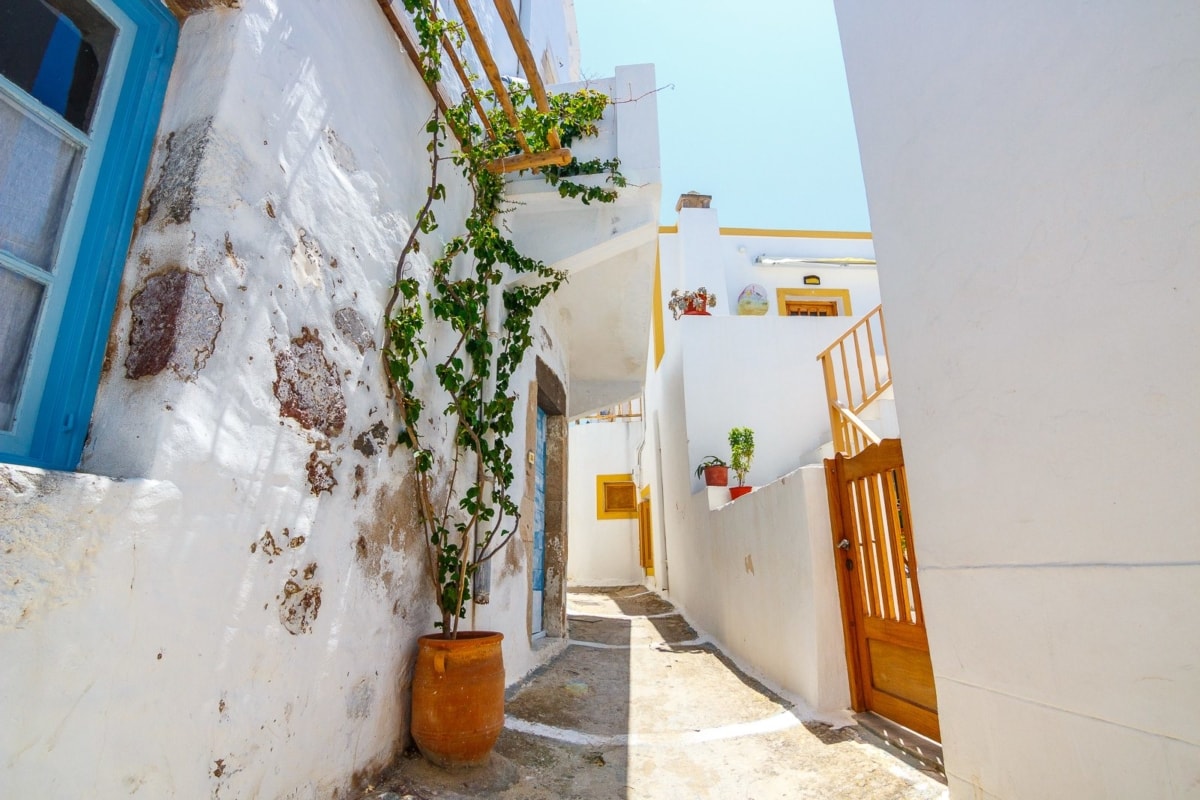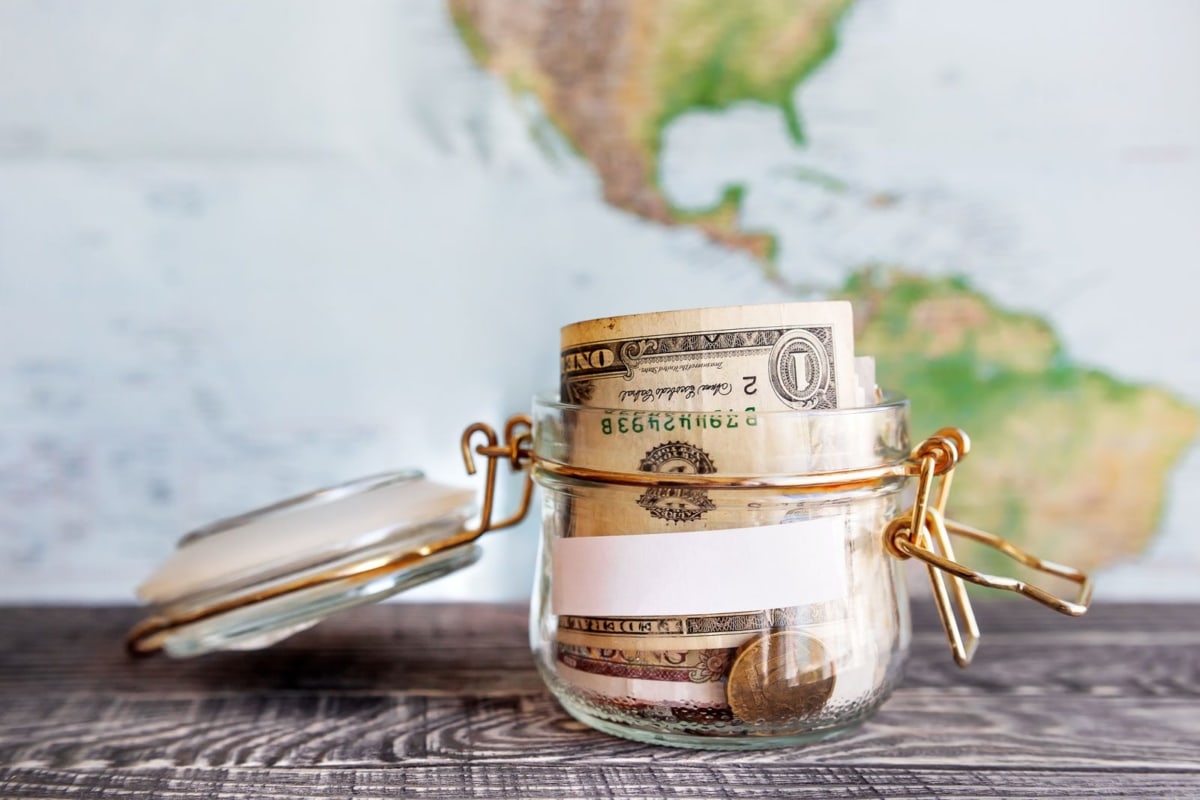I’m not going to tell you how to save up as much money for travel as you can in the fastest time possible. If you follow this guide, you’ll be able to put away a higher-than-average amount on a long-term, consistent basis, and save up money for travel every month.
How to Save Money for Travel: You Don’t Need to Stop Drinking $5 Lattes
If you read any blog post out there about how to save money for travel, they all parrot the same advice: Stop. Drinking. Expensive. Coffee.
The idea is simple: if you spend $5 on a latte every day, you’re spending $150 per month or $1,800 per year that you don’t really need to be spending. Well, sorry, guys. I love expensive coffee and there’s just no way I’m giving it up.
How can something that I enjoy be a waste?
There’s something about the process of getting a coffee. Standing in line, placing the order…the very first sip, and the froth on my upper lip. That ritual is comforting to me. It’s a small escape from my day that clears my head, and allows me to decompress. For that alone, it’s two grand per year that I’m willing to part with.
But I’ll be honest with you—it isn’t really about the coffee. It’s about the fact that I love coffee, and there are people out there who are telling me I have to stop drinking it if I want to save money for a trip.
Well I think that’s bullsh*t. There is no reason we can’t enjoy the things we like and travel at the same time.
How to Save Money for a Trip…or Anything, Really
The real problem we encounter when trying to save up money for travel isn’t actually our inability to save…it’s how good we are at spending.
We don’t take an honest inventory of what we’re buying and what we’re spending. We pay for things blindly, only thinking afterwards (usually with quite a bit of shock) about how much we actually spent.
How many times have you opened your bills, winced, then shrugged and said, “I guess I spent that much?” –Ramit Sethi
Ramit Sethi is the financial advisor we all wish we had. His New York Times Bestseller, I Will Teach You to Be Rich, has some insanely relevant and practical advice for 20- and 30-year-old’s like us. He’s also funny as hell.
The title is audacious, I know, but its pages are gold. This book has probably made more of an impact on my adult life than anything else I’ve read.
Sethi lays out exactly how we should be structuring our finances as young professionals. His advice isn’t about how to save as much money as you can. It’s about balancing your life and your finances so that you always have the money you need to do the things that you want.
The crux of his spending plan is actually quite simple. Instead of looking back at your spending at the end of the month, you look forward and decide how you’re going to spend the money you have.
When you make more calculated decisions with your finances, you can be proactive about putting a certain amount of it away for savings.

Step 1: Restricting Spending vs. Prioritizing Your Interests
The problem I have with these guides to saving money for travel is that they focus on restriction. When we restrict ourselves, we don’t live an enjoyable life, yet the whole reason we’re traveling is because we want to have fun. Does that make sense to you?
If you want to save up money for travel, sure, you could cut every last expense you have and save every dime. But that’s not a reasonable or sustainable approach for the majority of people.
You don’t have to be miserable during the saving phase just so you can appreciate the travel phase.
Plus, if you want travel to be a part of your life, you’re going to be saving up for a long time, over and over again. You need a sustainable plan.
Instead of cutting things out and focusing on restriction, you should be more focused on spending money on the things you enjoy and not the things you don’t. It’s pretty straightforward, actually. Make more room in your life for the things you love, which leaves less room for the things you don’t.
Not only is this good money advice, it’s good life advice.
It’s funny because we learn so many things in school about how to make money when we’re older, but we learn almost nothing about how to actually manage the money that we make. My parents never taught me how to handle my finances, and I’ve made some costly mistakes because of it.
My guess is that nobody ever sat you down and showed you how, either, and that’s exactly what I’m going to do now.
Let’s Do an Exercise…
Write down all of your monthly expenditures. Seriously, grab a piece of paper or open a text document on your computer and start writing. I’ll wait.
If you want to make things easier, you can try the spreadsheet I created to help you with this exercise. You just enter the numbers and it magically tells you how much of your income you can afford to allocate for different aspects of your life, including travel
Get started saving and download the worksheet that will help you figure out how much money you can save for travel every month.
- If you downloaded the worksheet, just enter your income in the first section and what you spend on your monthly essentials in the second. Essential items are rent, utilities, groceries, student loans, etc. If you’re using a piece of paper, add it all up for a monthly total.
- In the next section, start filling out your other monthly expenses (or create another column that lists everything else). It could be Spotify, Netflix, coffee, a gym membership, whatever. Write down every single thing that you spend money on every month, and add it all up.
- Now figure out which ones are your high priority expenses and which ones are your low priority expenses, and put them in different lists. Do you see any trends?

Step 2: A Spending Plan That Helps You Save Money for Travel
Once you’ve figured out what you’re actually spending every month, you can start to look at how you’re spending it. Use the guidelines below and compare your current spending trends. How much more or less do you need to spend in each category to hit the targets?
- Rent, utilities, groceries, loan payments and other essentials should cost about 50% of your take-home pay. How does your total number compare to this? You might need to adjust your lifestyle if you’re spending more than this. If it’s less, good on ya!
- The money you spend every month should be somewhere between 20-30% of your take-home pay. Take a look at your list—is your total spent monthly about half of your rent/essentials? It should be.
- Your savings for travel should also be about 20-30%, but you can reduce this to as little at 10% if you’re happy to spend more on your day-to-day life and save a little bit less. It all depends on your goals.
At the beginning of every month, pay your rent, pay your credit cards, and transfer money into your savings account. Once you’ve paid for your essentials, whatever is leftover in your checking account afterwards is everything you get for the month.
You can safely run your checking account down to zero, knowing that you’ve already paid for and saved everything you need to.

The rule with your leftover spending money is that you are only allowed to spend it in exactly the way that you decide ahead of time. Let’s say you have $500 leftover to spend every month. If you allocate $200 for going out with friends, once you use up the fund, you’re not allowed to go out anymore. You have to be willing to decline and spend a night in with Netflix instead.
If you overspend on going out, then you give up something else, which is exactly what we’re trying to avoid—giving anything up.
So you have to look at your list of high priority and low priority items, and decide how much you can spend on each item. Can you reduce any of your low priority expenses while keeping your high priority ones?
For instance, even though you might enjoy going to the gym, would you be willing to give up the monthly fees and work out at home instead? Can you shop around for a better rate on your renters or homeowners insurance?
What about TV? Could you give up everything but Netflix?

When you look at the numbers, you may realize that you have to restructure your lifestyle a little, but you don’t have to give up the things you love.
According to Forrest McCall of Don’t Work Another Day, making travel a priority in your life doesn’t mean that everything else should be ignored. Knowing where your money is going ahead of time is the key to spending it wisely.
Following these basic guidelines, I’ve managed to save a few thousand dollars in just a couple of months (while paying off credit cards and traveling at the same time). That’s pretty good, as far as I’m concerned.
The best part is that you only have to do this restructuring one time with small bits of maintenance and tweaking along the way. In complete honesty (and I’m not just saying this because it sounds good), a couple hours of your time could end up paying for your next vacation.
Step 3: Saving Money While You’re Actually Traveling (aka The Same Advice)
A few months down the line, once you’ve reached your savings goal and you’re ready to go travel, please don’t see this as an opportunity to splurge. The basic rules of money (unfortunately) still apply.
You should follow the same structure of prioritization, and work out how much of your budget you’re ready to spend on each facet of your trip. Different countries have different prices for things like food and accommodation, so you’ll need to take this into account as well.
Sometimes, depending on the country, it can work really well in your favor.
If you decide that you’re going to budget $25 per day in China, work out how much everything costs ahead of time, allocate the appropriate funds, and whatever money is leftover is what you get to play with.

If there are certain things that you value, continue to prioritize them! Want to keep drinking $5 coffee? Include that in your travel spending plan up front.
If staying in hotels is a priority for you, then feel free to spend your predetermined amount on it! And if not, then you can stay in hostels.
When you follow the same guidelines while you’re traveling, you realize that you’re not giving anything up at all—you get to enjoy everything that you want and you get to spend your money however you like. You just have to choose where it goes ahead of time.
Tools I Use to Manage My Spending
It’s hard, nay, impossible to keep on top of this stuff without a few tools in your arsenal. Here are a couple that I use:
Mint
Not only does Mint aggregate all of my transactions from all of my accounts, but their budgeting feature is how I keep track of my spending money. Since I rarely use cash, I set a budget for different categories (like restaurants, bars, and coffee shops). As each transaction gets categorized, I can see how much of each budget I’ve spent that month. Once I hit my limit, I stop.
TrailWallet
This is how I keep track of my expenditures while I travel. TrailWallet supports multiple currencies with updated exchange rates, plus categorized transactions for easy organization and analysis of your spending—it keeps me cognizant of what I’m spending each and every day. For more information, you can read about their app and some of my other favorite apps here.

What Banks I Use and How I Use Them
Not all banks are created equal. As an American, these are what I believe to be the best bank accounts for travelers. Big banks (like Bank of America) like you hit you with unexpected charges. I use the banks below and I never get charged a thing.
I also included my favorite service for overseas money transfers.
Charles Schwab High Yield Checking
I’ve talked about Charles Schwab before. Their High Yield Checking Account is the only checking account that makes sense for Americans who travel.
They don’t charge foreign transaction fees, their cards are chip-enabled (helpful in Europe), and you don’t get charged ATM fees anywhere in the world. That means you don’t get charged for using out-of-network ATMs in the US, either.
360 Savings from Capital One
360 Savings from Capital One has the highest interest rate of any online savings account I’ve found. Gone are the days of 3% interest, but Capital One 360 offers about 1% whereas many other savings accounts offer somewhere in the range of 0.5%. It’s not a big difference, but their site is also really easy to use and they let you create sub-accounts, so you can save up money for various different things in different accounts at the same time, instead of putting everything in one big account.
Wise (Formerly TransferWise)
Wise is the cheapest, most reliable, and user-friendly way to send money overseas and between currencies. Whereas many companies charge 3% or more plus inflated exchange rates (I’m looking at you, PayPal), Wise charges about 1% at the real exchange rate.
Basically, they check all the boxes. Click here for my full review of Wise.
PayPal
PayPal is, unfortunately, the industry standard for sending and receiving payments online. I say unfortunately because they charge extremely high fees. I don’t like using them because I sometimes end up paying hundreds of dollars per month in fees, but sometimes they’re the most convenient. There are some workarounds for the fees, but it’s complicated.

There you have it. My guide to managing your finances in a realistic way so you can save up money for travel. If you have any tips to add, leave them in the comments below!
READ NEXT:
Saving for Travel FAQs
-
How much money should you save before traveling?
The amount of money you should save before traveling totally depends on the type of trip. You can take a weekend road trip for less than a nice dinner!
-
How can I save money for vacation?
The best way to save money for vacation is to set clear priorities, make a budget, and stick to it.
-
How can I save money to travel the world?
The best way to save money to travel the world is to be very specific about your goals, create a spending plan, and stick to it.
-
Is $4000 a good savings?
$4,000 is a great starting point for savings. Once you have any debts paid off, you’ll want to start building that up more.
-
Is travel expensive?
The cost of travel totally depends on the type of travel. If you’re on a tight budget, don’t worry. You can still afford to travel, you just have to approach it differently.


This is such a useful post! I’m traveling around Aus with no income at the moment, but once I start making money again, I’ll definitely be referring back to this post. Also, have you checked Ally Online Savings account? When I signed up, I received 0.8% interest, but last I checked it was at 1.0%. It may have changed but it’s worth a look!
I haven’t heard of them, so thanks for the tip! I’ll check them out.
One great piece of advice I give is to actually work abroad if you’re trying to save money quickly. Rather than work two jobs in the US and limit yourself, you can make a decent bit of money working abroad and you don’t have to just teach English. I work as a college counselor in China and I was able to save $5,000 USD in 6 months despite the startup costs of moving here. I go out, I buy expensive coffee, and I take taxis sometimes. I have a great quality of life and I’m hopefully going to pay off $20k in student loans in less than 2 years, meanwhile my friends back home are living paycheck to paycheck.
Great tips though- I wish I could use TransferWise to remit money back to the US from China but my bet is that it probably doesn’t work due to government controls… womp womp.
This is so freaking good. Sending it to Nathan immediately lol, so we can put this stuff into practice. Love these tips, Jeremy, and I know this approach will help a lot of people. And it’s a way to look at money that doesn’t make you feel like you’re suffering.
Awesome piece!!!
Also, I LOVE my Schwab account. Best banking decision I ever made. Gonna look into Capital 360 for Savings tho…as you said it is far too easy to transfer funds when they’re in the same bank.
I’m glad you found this helpful! I really recommend Ramit’s book as well.
I think one of the best things I ever did was make my savings account less accessible. It’s too easy to transfer money out when you just need a quick 50 bucks.
Nice advice. I’m not too bad at it though, ‘cuz I don’t have that much in the first place. As for coffee, I’ve had to stop drinking it. Cuban cigars, now that’s another matter, but I only have one when the fat lady sings.
Ha! We all have our vice 😉
I love the way you approach this post. I get a bit over those posts that say “give up coffee” or “stop eating out” – usually a giant list of things I don’t do anyway! Granted I can’t save much at all right now as my husband is too sick to work so two people on one income doesn’t stretch, but the principles above are basically what we’ve always done. Pay bills, appreciate the rest!
I know what you mean. I guess you’ve gotta take care of what’s important for now. Plenty of time to travel later, but these rules apply not only to a travel fund, but any saving fund. Sounds like you’ve got the hang of it already!
This is a very realistic post! For us, it’s all about priorities in how we spend our money. Travel means more to us than material items for our home.
That’s the biggest thing—prioritizing, and then putting your prioritization into practice.
Awesome post and Nice advice. Thanks for sharing this.
I can’t download your worksheet 🙁 help please 🙂 <3
Oh no! Thanks for letting me know. I’ve just fixed it. You should be able to download it now 🙂
Awesome! thank you! Keep posting <3
Hi! I can’t seem to be able to download the worksheet either 🙁
Hey Florencia! Check your email—you should receive a link to the worksheet. Feel free to let me know if you’re still having issues!
Excellent post. The only caveat with the Charles Schwab account is that you can not be out of the country for more than 6 months without them shutting off your debit card. I am a full-time nomad and was told by a Charles Schwab representative that it doesn’t always happen, but it could because those are the terms of their accounts. Capital One 360 does not have a travel time limit as long as you keep them updated with travel notifications.
Just don’t tell them! You could also have someone back home with a second card access your account from the States.
Thanks for the awesome post! Great advice right up my alley- I also am an avid Ramit fan. I’m looking forward to reading more of your content. I have to say, every time I see your blog name, I laugh. “Freak” is one of my favorite words. Keep the great content coming!
Sarah
Hi
Great article. You are right, the PayPal service charge is very high. Even the exchange rate is also not good. But PayPal majority trust PayPal
Unfortunately it’s the industry standard, which means many people, including myself, are locked into using it!
Thank you so much for this! As someone who likes to socialize but still wants to travel this has been an awesome take on saving. I can save and not miss out on spending time with mates. Also I tried to download your worksheet and it is not working for me 🙁
Thanks Again! Jen
Thanks for this post! Great article 🙂
I’ve been traveling around the world for the last 7 years. Adventure travel & photography are my passions. Let me inspire you to travel more with crazy stories, photography, and useful tips from my travel adventures
when you travelling first you need to save money as much as you can so this blog tells many things about saving money when you travel. Thanks for sharing.
Awesome and some great tips here.
thanks for sharing with us.
Thanks for sharing informative blog .. thats a very comprehensive article for money saving.. i have learning lot of things and gain our info.. good
It is sensible and helpful information! shared your details really helpful for Save Money for Travel because saving is a difficult task due to different vendor provides free codes for saving money.
I was sort of expecting something revolutionary here and then found out that I actually knew it all, which at first was a bit upsetting (no revolution for me) but then it just struck me how lucky I am to have had my parents teach me all that, because to a lot of people this MIGHT be actually revolutionary. Whoa! 😀
I’d say you’re off to a great start, then! Kudos to your parents!
Hi
Great post. Yeah really what you said is true, service charge for paypal is very high and the exchange rate is also not good. But majority of people trust PayPal
Excellent tips are shared here! I really like this post and bookmarked your site for latest post.